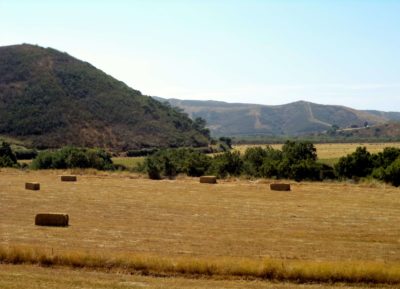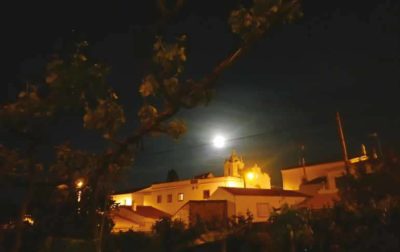After breakfast we bid you farewell.
Via Algarviana from Alcoutim to Salir - First Section



Services
- 24/7 On-Call Support
- Specially Hand-Picked Accommodations
- Bed & Breakfast
- Dinners
- Roadbook
- Luggage Transfers from Hotel to Hotel
- Extra night stays
- Airport Transfer
- Flights/trains
- Insurance
- Drinks
- Lunches
- Dinner (in Cortina)
Itinerary
Alcoutim(Arrival
You will be met at Faro airport and transferred to Alcoutim where you will be welcomed by Mrs. Rosario, the owner of Brisas Guadiana guesthouse. Alcoutim is a hillside town that sits on the bank of the Guadiana River, which is also the natural border between Portugal and Spain. The cobbled streets and small squares with their backdrop of rolling green hills are made even quainter by the boats floating gently on the river. A real contrast to the more widely known south coast and its beaches, Alcoutim provides a tranquil setting from which to begin your journey. If all the fresh air is making you hungry then be sure to try the local traditional dish of barbecued fish which is freshly caught from the river.
24km
Balurcos
Setting off today you will initially follow a track north alongside the river surrounded by dry fruit orchards of almonds, figs and olives. Heading away from the river you will then meander through valleys, small towns, and villages where you will see not only traditional schist houses but also long-established kitchen gardens that will provide plenty of opportunities to get some lovely photos. In Cortes Pereiras, you can stop for a drink or coffee at the snack bar. Continuing on through extensive woodland, you will then traverse rolling hills and quiet villages before ending your day in the quiet village of Balurcos, where Mr Faustino and his wife Mrs Fernanda will welcome you at their house, Vales das Hortas. (Note: it is possible to reduce this walking day in half by booking a transfer from Corte Tabelião to Balurcos in advance)
14km
Furnazinhas
Today’s walk is much shorter and will be a welcome break after the undulating landscape of the day before. Leaving Balurocs, today’s walk will begin out flat but then does begin to ascend. You will pass through young forests and areas of dense Cistus, which when in bloom add a touch of colour to the green landscape. Reaching the Foupana stream (Ribeira da Foupana), which is the main stream in this area of the Algarve and also the best preserved, you may take the chance to rest on the pebble beach that is present when the stream is low and revel in the natural tranquillity of the ravine. Before setting out today, it would be worth checking with locals on the flow of this stream as it can become more challenging to cross if there has been any heavy rain. Emerging from the ravine of the Foupana, the trail enters a Holm Oak forest before arriving into the village of Corte Velha which will allow you spectacular views over the region that you have just walked through. Not much further ahead now is your final destination for today, Furnazinhas, the home of cane basket weavers, a craft that has been passed from generation to generation. In Furnazinhas, you will see many examples of these baskets that are the ideal storage for the local family-sized loaves. To enjoy this fresh homemade bread like a local be sure to trickle honey onto the goat’s cheese and bread for a sweet homely taste of this region. Welcoming you today will be your host Mr João Henriques at Casa do Lavrador.
20km
Vaqueiros
Today’s walk will be more arduous with some sections of steep terrain, tracks crossing several streams and passing through deserted villages, so it is worth being prepared with water and snacks for the day. However, you will be rewarded with sweeping views of open fields and pastures as well as the occasion to stop and appreciate the view at Monte das Preguicas. Continuing on to the sleepy village of Malfrades, then meandering through lush green rolling hills, you will arrive at your final destination for today, Vaqueiros, the most populated village in this parish. Evidence of the existence of a rural community here goes back as far as the Arab period and in this remote location, self-sufficiency is apparent with most homes having kitchen gardens enabling them to feed themselves throughout the year. Fresh bread and cheese is a particular specialty of this town and even has its own festival in March and after today’s walk, you will not be disappointed with the quality of home cooked food you will have for dinner. The owner of the Casa de Pasto Teixeira snack-bar, Mrs Rita, will welcome you and serve some drinks before showing you to your accommodation.
14km
Cachopo
Although not a long day, the landscape is undulating in its climb and we would recommend that you bring a picnic as there will be no opportunity to buy food today or drinks but plenty of places to stop for a well-earned rest and reviving picnic. Leaving Vaqueiros heading southwest, the scenery is awash with cistus which adds a delight of colour to the landscape when in bloom. Despite the steep terrain, the natural viewpoints provide many instances to stop and drink in the landscape and wander in the Stone Pine plantations, where the trees appear to be clinging to the steep dry slopes. These Stone Pine plantations, although not native to this area but thrive in this arid soil, are planted due to farmers receiving funding as the trees’ produce pine nuts which are highly valuable edible kernels. Passing through quiet hamlets with well-maintained kitchen gardens and working farms you will also see the typical water-wheel wells that can be found throughout the region. After passing through Casas Baixas you will notice the landscape starting to change as you enter into an area of Cork Oak forest, a tree that is native to Portugal and its bark is an important part of the local economy as it is both incredibly environmentally friendly and sustainable. Arriving into Cachopo you are greeted with traditionally built houses and in the centre of the village is the Santo Estevao church. If you arrive early to Cachopo you might even get the opportunity to go to the museum on medronho making, a traditional fruit brandy that is made in the region otherwise known as ‘firewater’. Are you brave enough to try this local spirit? Mr Manuel, the local taxi driver will bring you back to Vaqueiros for your second night there
29km
Baranco de Velho
Due to the length and difficulty of this walk, it will be cut in half and a transfer will be waiting for you after 15kms. Trekking from Cachopo to Baranco de Velho will see you moving through the Serra do Caldeirao, a stunning protected area of rolling hills, cork trees and scrubland and is renowned for its variety of birds. Although much of this area still bears the scars of a great fire in 2012 you can now see the vegetation regenerating and provides a powerful reminder that life goes on. Trekking through a forested landscape of Cork Oak trees and Strawberry trees that is blanketed with Heathers and Cistus you will pass also through charming small villages where you can sample or purchase some local produce including Medronho which is made from the Stawberry Tree and honey and may waken your spirits to keep you going! No encouragement, however, will be needed to appreciate the captivating views that will provide ample opportunity to take some memorable photos before you take a well-earned rest at the Odeleite stream. After the stream, you will have a 45-minute climb up to Parises where your transfer, Mr Nuno will be waiting to take you to Barranco do Velho and your accommodation Tia Bia. Here you will meet your first young couple in the Via Algarvina, Nuno and Cátio, your hosts for tonight.
15km
Salir
Today’s walk is much easier than previous days. Starting out relatively flat you are accompanied by panoramic views that as you progress allows you to see all the way to the coastline and provide ample opportunity to capture some amazing photos. Descending into a wooded ravine and passing through more Cork Oak forests till you come to the Rio Seco stream which marks the change in landscape from mountainous to agricultural land and where the pace of life begins to pick up. Arriving at your destination for the night, Salir, where mysticism and folklore of the area are as very much a part of their culture as the beautiful orchids that thrive in this area in spring. The very name of the town means disappearance and legend has it that the town received its name after the daughter of Aben-Fabilla, a Moorish alcalde. The army of Alfonso III captured his daughter so he turned her into a statue of rock that later disappeared. Here you can also visit a working distillery of Medronho. Your host for tonight is Mrs Garciete who will be waiting for you at her guest house, Casa da Mãe.







Share on